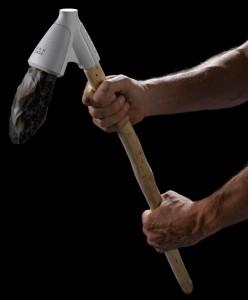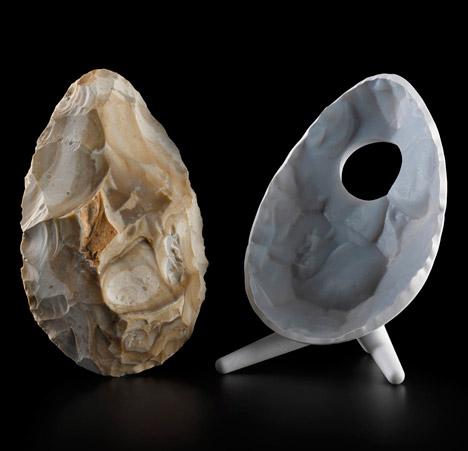In any show, exhibit, or book about pre-historic life you’ve seen the tear drop shaped hand axes that people used as an all purpose tool. Made from flint or other local stones, the shapes vary surprisingly little over time, or from location to location. In our time of mind-boggling specialization, this type of generalized implement usually arouses interest only as a way of contemplating the primitive. However, while the hand axe is only one object, it did have many specialized functions that make it a much more refined accessory to life than you may realize at first.
Designers Ami Drach and Dov Ganchrow were interested in pulling apart the various functions of the hand axe by combining it with 3D printed handles which supported a particular possibility inherent in the tool. In order to fully understand the form and character of the hand axes, the team first learned how to make them from flint, which was brought from the Israeli desert. This was a low-tech learning curve for the duo and Granchow admitted, with humor, that at the beginning there was as much learning as there was bleeding.
After they had perfected the art of making the hand axes, they used a 3D scanner to import the forms so that the handles they made would fit to the exact tolerances required. For the scanning itself, they turned to the department of archaeology at Hebrew University, a program that has embraced the possibilities for 3D scanning as a way of recording precious historical objects.
With the objects scanned, they then designed a series of nine handles, each of which turned the hand axes into creations with singular functions. The newly combined objects, flint axes and Verogray polymer, created tools for chopping/pulling (Number 10), digging/pounding (Number 8), and percussive chiseling (Number 3) among others (Images are labeled to the left and below). The handles don’t simply act to restrict the possibilities of the axes but instead enhance the ergonomics of each activity – a benefit of specialization that is often overlooked in the quest for differentiation through style. This sort of function reduction is a particularly interesting exercise within the context of theories of despecialization, which allows the user to determine the use.
While at first glance the handles may appear to be simply elegant but functional, there is some real beauty in the interface between the 3D printed surface and the flint knapped axe. The very process of creating both, leads to the details of the aesthetic rather than being imposed upon it. It is for this same reason that the axe heads have remained beautiful objects even after they were no longer useful. The emergence of the inner surface of the handle makes the axe appear to have almost been simply freed from its 3D printed case, somewhat like Michelangelo’s slave sculptures began to liberate themselves from their surrounding stone.
Drach and Ganchrow have opened up a fascinating line of inquiry with this project and shown that just because you create using high tech doesn’t mean you should stop going back to basics. What do you think about Drach and Ganchrow’s work? Discuss it in the Pre-historic 3D prints forum thread at 3DPB.com.
Subscribe to Our Email Newsletter
Stay up-to-date on all the latest news from the 3D printing industry and receive information and offers from third party vendors.
You May Also Like
NSF Awards Kentucky $1M for Advanced Manufacturing
The National Science Foundation has awarded a $1 million grant to the University of Louisville for the Advancing Manufacturing and Building Construction Technologies (NSF AMT) project. This initiative is part...
3D Printing News Briefs, May 11, 2024: 3D Printed Stent, Tower, Sculptures, & More
We’re starting off with medical research in today’s 3D Printing News Briefs, as researchers in Korea used CT images and 3D printing to fabricate an educational simulator for a mastoidectomy....
3D Printing Unpeeled: Wind Turbines, Probiotics and Lenses
TPI Composites, ORNL and Ingersoll Rand are working to make wind turbine tooling segments that can be 18.3 meters long. These elements also include resistive wires that help keep the...
Tethon 3D Releases Cost-effective Bioprinter
Tethon 3D, known for its ceramic-loaded DLP materials, custom resins, and DLP 3D printers, has recently released a bioprinter. Vat polymerization printers like DLP systems have been widely used by...




































